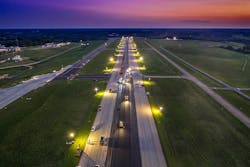2022 Airport Business Project of the Year: Blue Grass Airport Repaves Its Commercial Runway in 72 Hours

When Blue Grass Airport (LEX) leaders knew the airport’s Runway 4-22 needed pavement rehabilitation, they had to determine how to address the issues without impeding traffic.
Instead of spending months on incremental closures, LEX decided to address the pavement issues in a 72-hour timeframe so they could get traffic up and running quickly.
“Our approach has been that we get a much better product whenever we put it all down at once. There are thousands of feet of joints that would’ve been in place if we had done it in an incremental approach,” said Mark Day, director of development and facilities for LEX. “It’s going to save our airport and our airline users a lot of money in maintenance over the years not to mention buy us a couple of years before having to do this project again.”
The airport started seeing signs of degradation of 4-22’s asphalt during its 2013 master planning. They identified they would need to rehabilitate the runway in coming years and aging lighting on the airfield.
“The surface was exactly 15 years old almost to the weekend of replacement,” Day said. “We also have concrete underneath the asphalt that has been there since around 1940. It’s in good condition as the foundation of our pavement, so we keep resurfacing over it.”
LEX and HDR collaborated with the airlines and other stakeholders to develop rehabilitation and safety standards updates that met the requirements of a complex, $16.2 million plan.
The Blue Grass airfield contains several nonstandard features such as runway gradient and transverse grades. The team helped airport staff develop a scope of work that efficiently leveraged available federal funding.
The project involved months of preparatory work. Day said crews started the airfield lighting upgrades three months in advance getting the light fixtures out of the pavement before the paving weekend.
Timothy Ward, design project manager and construction manager with HDR, said crews were performing a variable depth mill with a 3-inch nominal overlay, so they needed to address about 34,000 linear feet in cold joint crack repair leading up to construction weekend.
The airfield also had 318 flush mount lights on the airfield, which had to be pulled out, capped and backfilled prior to milling.
“Everyone just had to be more prepared,” Ward said. “During normal construction, you have the ability to make adjustments as needed, but accelerated construction with an end date, we had to think about all the what ifs well in advance.”
American Airlines, United Airlines Allegiant Airlines and Delta Air Lines operate commercial service at LEX. Day said leaders started coordinating with them two years in advance so they could plan their scheduling in advance of the project.
“We didn’t want them surprised in anyway,” he said. “From an operations perspective it was very important that they had advanced notice and that we stuck to it.”
Although 4-22 is separate from the general aviation runway at LEX, Day said they suspended all flight operations during construction weekend. The airspace intersects so they didn’t want general aviation users to cope with the lighting required for nighttime construction or tall construction equipment.
The airport considered moving up the project to 2020 due to the drop in air traffic from the pandemic, however, they were only able to get partial funding from the FAA at that time. Day said they used the funds to mill and overlay the parallel taxiway to 4-22, which put about 20 percent of the asphalt tonnage in place for the project.
During construction weekend for the runway, the project was divided into three phases. The first phase was milling, the second phase was the paving and the third phase was markings.
“We were able to reduce the total number of linear feet of cold joints by almost 60 percent, which significantly reduces the maintenance burden on Blue Grass Airport for years to come,” Ward said. “Another opportunity was we were able to make grade improvements along the runway. If we would’ve had to do that nightly, it would’ve significantly increased the challenges of making a grade improvement.”
Day said the two major asphalt contractors in the Lexington region bid the project as a joint venture to produce the tonnage per hour required for the project. Almost all of the pavement went in during a 20-hour window.
Over the course of the weekend, the project’s contractor scheduled about 500 people for work on the runway. At its peak, as many as 300 construction crew members were working on it at the same time, in addition to nearly 100 others from the airport and consultants supporting the project. The effort entailed nearly every asphalt resource in the Lexington area.
Planners were also straddled with concerns about paving crew members being potentially exposed to COVID during the work.
“Our general contractor and all of their subs did a great job of self-isolating their employees leading up to the project because they understood how crucial it was to accomplish every piece of that project during that closure weekend,” Day said.
Day said planners had a list of things that could go wrong during the project and made strategies to address them before they arose.
“This is my second time through this project,” Day said. “I was on the team in 2006 and the amount of coordination that was done in advance between the design and construction administration team, the contractor and our staff and the months leading up to it, all the challenges were addressed.”
In addition to new pavements on the 7,000-foot runway, enhanced safety features were among the highest priorities, including an Engineered Materials Arresting System (EMAS).
The Runway Safety Area (RSA) at LEX is 600 feet on the end of the runway and it’s positioned on the edge of the hill, which doesn’t meet the 1,000 feet requirement set by the FAA. A 70-knot EMAS on both ends of the runway allow the airport to meet the safety requirement without having to either acquire more land or shorten the length of the runway by 400 feet.
The first EMAS will go in this year with the second planned for 2023.
“The FAA determined that 90 percent of all overruns happen at 70 knots or less and 90 percent of overruns happen within 1,000 feet of the end of the runway Trip Thomas, regional sales director for Runway Safe Inc., said. “If we can get an EMAS bed in there, that has predictive performance of stopping an aircraft at 70 knots, hence, you have the same level of safety."
Day said on one level it’s a routine asphalt replacement project,but taking it on all at once allowed LEX to make incremental improvements to the airfield beyond pavement.
“Going forward, we’ve got a more level runway, we’ll have energy efficiency through the LED lighting and this airfield is in good enough shape that hopefully we can take another 12 or 15 years off before we have to do another major rehabilitation,” he said.
- Location: Lexington, Kentucky
- Project: Runway 4-22 Rehabilitation
- Cost: $16.2 million
- Completion: August 2021
- Key Participants: Blue Grass Airport, HDR Inc. Runway Safe Inc.
About the Author
Joe Petrie
Editor & Chief
Joe Petrie is the Editorial Director for the Endeavor Aviation Group.
Joe has spent the past 20 years writing about the most cutting-edge topics related to transportation and policy in a variety of sectors with an emphasis on transportation issues for the past 15 years.
Contact: Joe Petrie
Editor & Chief | Airport Business
+1-920-568-8399
>> To download the AviationPros media kits, visit: Marketing Resource Center
>>Check out our aviation magazines: Ground Support Worldwide | Airport Business | Aircraft Maintenance Technology
